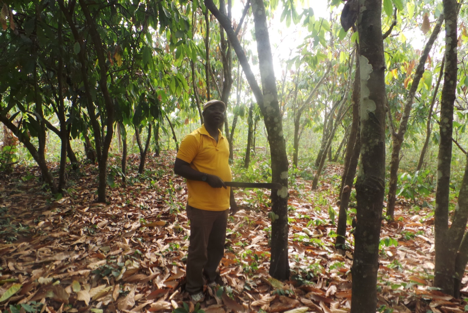Climate change and climate variability pose serious challenges to national development, especially agriculture – which is the backbone of the country’s economy.
Climate change leads to increases in temperatures, changes in precipitation patterns, changes in extreme weather conditions, and reductions in water availability – all resulting in reduction of agricultural productivity.
Undoubtedly, the variances of this year’s climatic conditions epitomise the impact of climate change, a situation posing serious threats to cocoa production and productivity.
The culmination of changes in rainfall patterns, and hot temperatures coupled with other factors like infestation by diseases, could adversely affect cocoa productivity for 2020/2021 and beyond.
Ghana’s Cocoa Board (COCOBOD), the industry regulator, is optimistic of hitting the target of one million metric tonnes… but the dynamics look different.
The cocoa plant can bear the right quantities if trees enjoy the specific climate balance to ensure strong growth, along with resistance to diseases.
However, this year’s cocoa season has been characterised by prolonged dry periods and heavy downpours. There was lack of rain for about three months – from June to August. Within the said period, it was very critical for cocoa trees to flower, pollinate and begin pod-bearing.
Lack of rain
In August 2020 and the first week of September, I visited some cocoa farms in the Ahafo Region, one of the leading cocoa production areas in the country.
In times past the region used to be a densely forested zone, but indiscriminate felling of trees has wiped away a great portion of its forest cover, making cocoa farms in the Ahafo area susceptible to hot temperatures. Lack of rain makes cocoa more vulnerable.
In line with COCOBOD’s productivity enhancement programmes (PEPs), the farmers had started hand-pollination, preceded by pruning.
At the material period, the plants were in critical need of water to fruit; but rainfall was elusive, igniting the fears of farmers.
According to experts, too long dry periods and lack of rain can affect cocoa pollinators and eventually cause low yield; hence the farmers’ apprehension.
In an interview with B&FT, the 2019 Best Regional Cocoa Farmer (Ahafo, Bono and Bono East), Philip Appiah Boakye at Akrodie said: “I harvested about 457 bags (64kg) in the 2019/2020 farming season and projected to increase production output to between 800 – 1,000 bags. However, the irregular rainfall pattern could erode my target. We farmers, with the support of COCOBOD, have done everything humanly possible to increase productivity; but lack of rain remains a major threat to productivity”.
On his part, Peter Adongo, Chairman of Agyarekrom Farmers’ Cooperative at Kwapong-Agyarekrom in the Sankore Cocoa district, said the erratic rainfall pattern is increasingly becoming a major threat to cocoa farming. “Decades ago, weather imbalance was not an issue of concern, but the dynamics have changed now. This year, the rate of flower abortion has been alarming. As we speak, most of the cocoa trees are fruiting – but due to lack of rain, most of the pods are falling prematurely,” he lamented.
The farmer passionately appealed for COCOBOD to fast-track and open up its cocoa irrigation scheme across farming communities so as to mitigate the negative impact of climate change on cocoa productivity, saying: “We the farmers are willing to support COCOBOD implement the programme by financing connectivity to our farms. At least, we need COCOBOD to drill the boreholes at vantage locations for farmers to connect to their farms”.
COCOBOD is piloting a drip-irrigation system at its cocoa stations, and it is expected to expand this to the farms to aid all-year-round production and increase productivity of each cocoa tree, and farmers’ incomes as well as.
There are about 28 strategic cocoa stations across the country’s cocoa production areas.
The COCOBOD Officer in Charge of Sankore Cocoa district in the Ahafo Region, David Gyebi-Afriyie, told B&FT that efforts have been made to intensify the implementation of PEPs such as pruning, hand-pollination, distribution of fertilisers and insecticides for the season under consideration so as to push productivity; but the greatest challenge is lack of rain.
He said the success of programmes like hand-pollination and fertilizer application is subject to rainfall. “The hand-pollination exercise had to be delayed for a while, there were not many flowers; meanwhile, the completed pollinated farms yearn for water as the developing pods continue to drop prematurely. We have sent a situational report to Headquarters to inform immediate implementation of the irrigation scheme across the farms.”
Impact of excessive rainfall
It has been established that too much rain can lead to increased insect and fungal infestation in cocoa production. After almost three months of no rain, it should have elicited a huge sigh of relief from farmers and the country at large – but it appears the situation might turn out to be curse. Since the first week of September it has been raining, but the magnitude of rainfall could compound the woes of cocoa farmers.
It has been virtually a daily downpour across the forest areas. According to Mr. Gyebi-Afriyie of COCOBOD, there is a tendency of black-pod disease outbreaks should the heavy rainfall pattern continue in the weeks and months ahead, adding: “There is need for a fine balance of rainfall and sunshine to enhance productivity, but not incessant heavy downpours”. Cocoa black-pod disease is one of the major diseases that affects cocoa production. Studies have shown that climate variables, such as heavy downpours, influence the cocoa black-pod disease incidence.
Conclusion
On the backdrop of cocoa production’s importance to the country’s economy and its invaluable contribution to the livelihood of millions of rural folk, it is imperative for the COCOBOD and all other relevant stakeholders to incorporate more climate change-mitigation initiatives like climate-smart agriculture (CSA) in their activities.
Climate-Smart Agriculture (CSA) is an approach to dealing with interlinked challenges in a holistic and effective manner, to sustainably increase food security by increasing agricultural productivity and incomes by building resilience and adapting to climate change.










